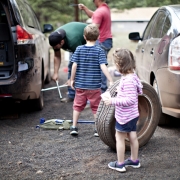How To Safely Drive on a Spare Tire
Spare Tire
Did you know that 60% of people claim that they can’t change a flat tire? Like it or not, we’re all bound to have that unlucky day when we have to switch out a flat for a spare. Whether you belong inside or outside that sixty percent margin, it’s safe to say a good share of people aren’t quite familiar with the ins and outs of what to do after they throw on their spare tire. Your spare tire can’t necessarily be treated like the tire it replaced, and there are some important precautions to keep in mind when driving on one. Should you find yourself having to continue driving with your spare tire, this short guide will explain how you can drive to best accommodate it.
Driving On A Spare Tire
Firstly, if you have any difficulty or uncertainty with the process of changing your tire or handling your spare, do not hesitate to simply consult a reliable roadside assistance service company. If you’re not completely confident with the process, it’s best that you don’t take the risk.
However, if you’ve changed your tire and are ready to go, here are some things you should keep in mind when driving on spare tires.
By its very design, most spare tires are slimmer, more compact and primarily designed to fit in your vehicle’s trunk. It also has very little tread compared to a standard tire. It’s made with long-term storage in mind, which means short-term driving. If you can, you should limit your distance to no more than seventy miles and your speed to no more than fifty miles per hour while your spare is attached. The size difference between the spare and your other tires requires varying power from your car’s transmission. This can potentially cause further car trouble or even breakdowns if you drive longer or faster than you should.
With this in mind, you should also be aware of additional complications posed by this disparity in wheel sizes. Do not use cruise control, be especially cautious on wet or icy surfaces, and take turns very slowly. Also, you truly never know when your spare tire might be needed, so it’s important to stay prepared before any problem actually occurs. Always make sure your spare is inflated to a pressure of 60 psi (pounds per square inch) or the recommended PSI on the tire. After all, it won’t do you any good to change out one flat for another!
Don’t Be Afraid To Ask For Help
Again, for any number of reasons, you might not be prepared or fully confident with the process of what to do after getting a flat tire. That’s completely okay, and you’re certainly not alone! It’s a troubling situation altogether, and we’re here to help. Whether you need a spare tire, your car towed, or your battery jump-started, Dugger’s Road Service is here to help. All it takes is one quick call, and we’ll be out to you in no time.
Are you having any roadside trouble? Give us a call today! 1-877-823-9696



